This story first appeared in Medicine at Michigan.
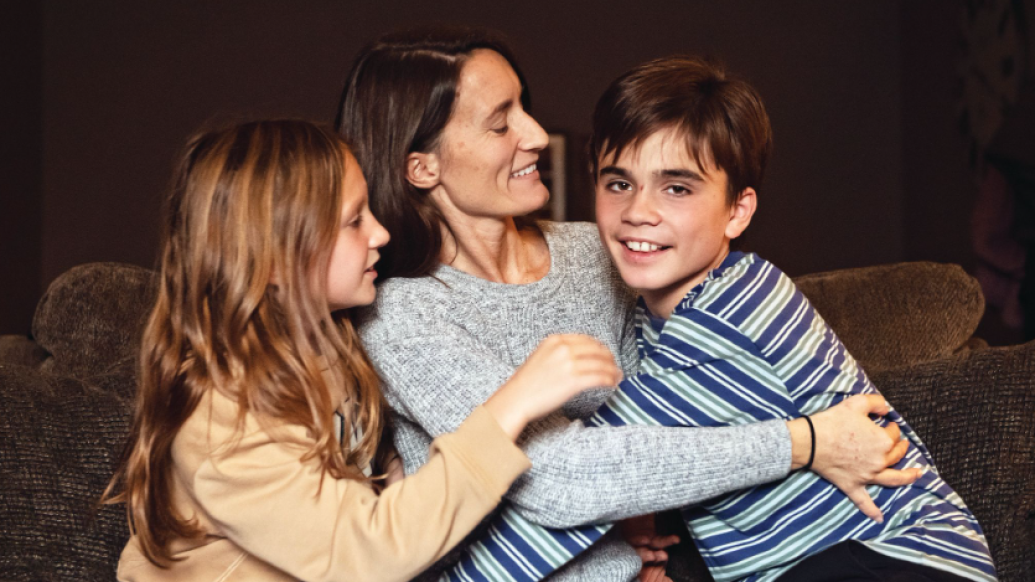
Last year, we looked at the children’s mental health crisis as a whole. In this story, we wanted to share some real patient journeys, to show the positive impacts being made on a patient-by-patient and family-by-family basis. While these stories are tough, they are also filled with smiles, giggles, hugs, and major wins. More importantly, they’re filled with the families and treatment teams who refuse to leave the sides of the children they love.
Finding a better quality of life
Liam Miltimore Kelley looks uncomfortable. His face is scrunched, and he’s eyeing his mother Kelly Miltimore with distaste. As he scoots away from her, she asks him what’s wrong. “I think you’ve overdone it on the lipstick,” he tells her. She grabs a paper towel, wipes it off, and Liam relaxes.
The signs of Liam’s autism began to show in sensory issues: the weed whacker down the street bothered him, for example. But it was his first birthday party that really clued Kelly in to the issue. “It was such a traumatic event for him. He was almost climbing up my body, like he just couldn’t get high enough as he tried to get away from the noise and the stimulus,” Kelly says.
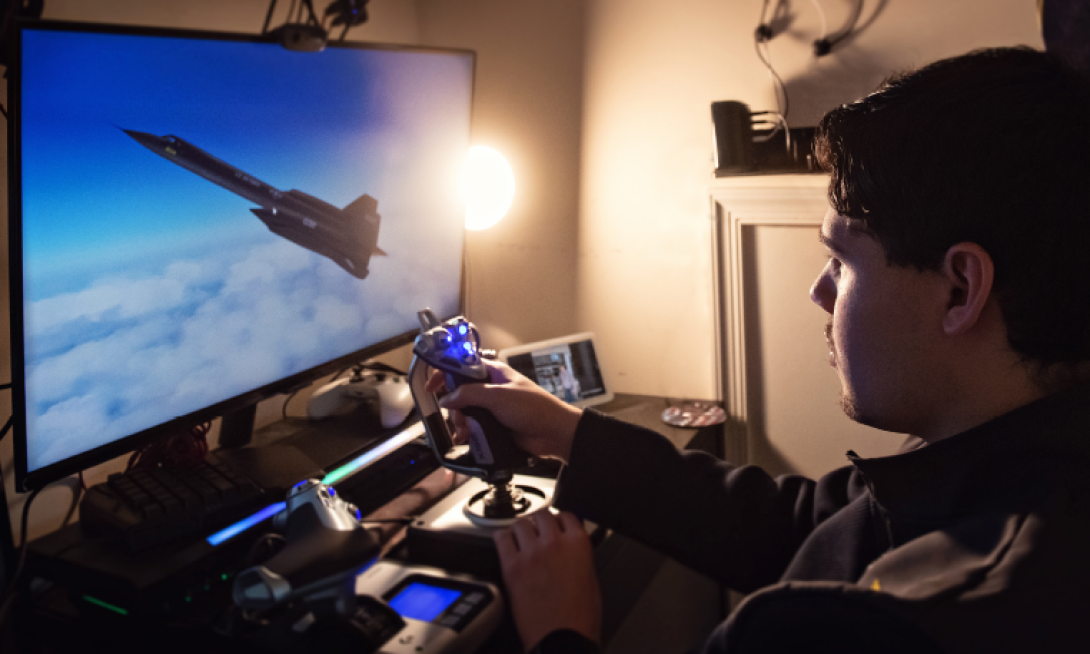
Liam Milltimore Kelley works with his mother Kelly and doctors at C.S. Mott Children’s Hospital to treat his seizures and manage his autism. Today he is 20, partnering with a job coach to find employment while he works to establish his own tech support business. Photo by Leisa Thompson.
By the time he was 7 years old, Liam began to have what Kelly calls “episodes,” during which he would become irrational, and at times violent toward himself, property, and others. In these episodes, Liam would cry for hours and lacked any ability to cope with his surroundings. “And when he would come out of it, he would be like, ‘Mama, why did that happen?’” Well-meaning friends suggested discipline and sticker charts for good behavior, but Kelly knew something was very different with Liam and was concerned for his mental health. “It was so obvious to me that these were not choice behaviors. He was struggling and suffering.”
Later, Liam began to have focal seizures — during these seizures he would turn white, look at Kelly through dilated pupils, and just say, “It’s happening.” A big one in the aisle of Meijer left him unresponsive and needing a life flight to the hospital. For months the seizures — sometimes 10 a day — continued. Eventually, Liam came to Michigan Medicine to see Nancy McNamara, M.D., associate professor of pediatrics, who pinpointed the problem: epilepsy.
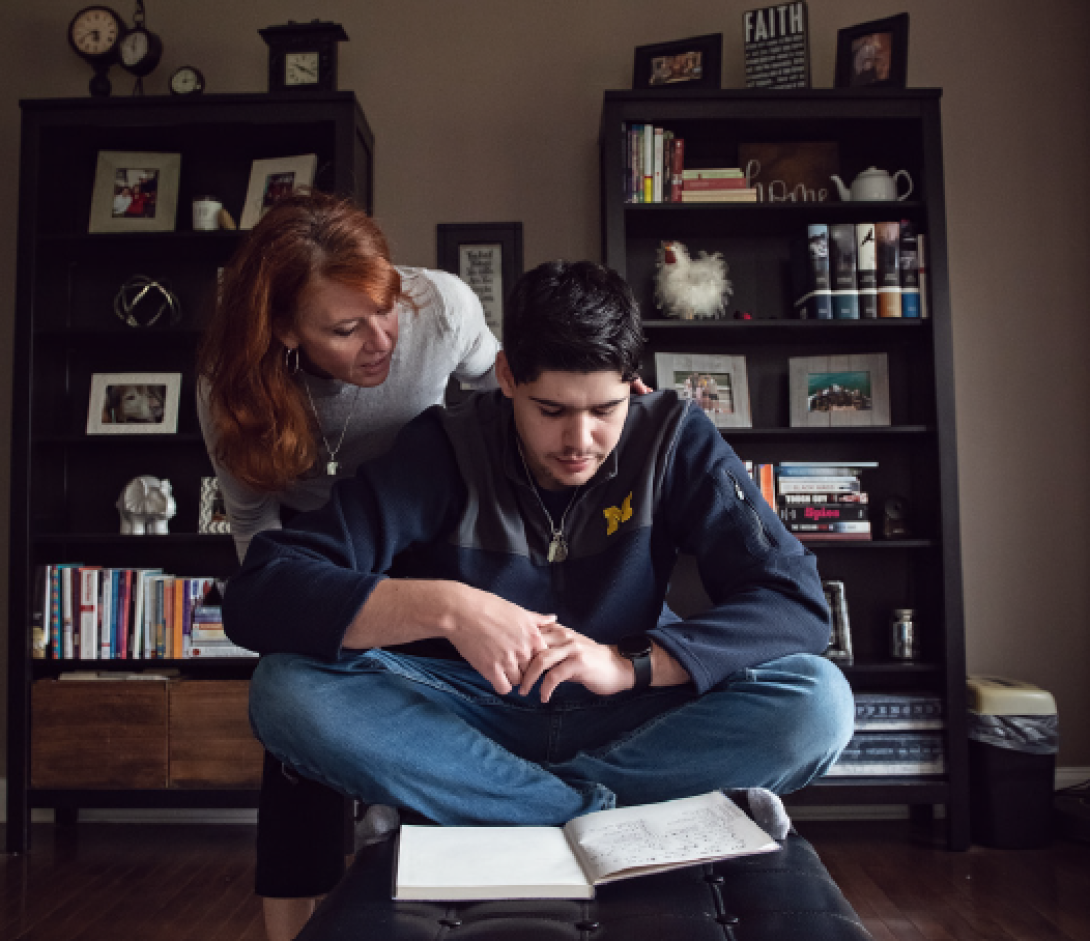
Liam has had the continuous support of his mom Kelly on his mental health journey. Photo by Leisa Thompson.
The mental health issues required other therapies when medications proved inefficient. With guidance from Neera Ghaziuddin, M.D., professor of psychiatry, and the team in the treatment resistant clinic, the route the family took to address the anxiety and what later was identified as bipolar disorder was electroconvulsive therapy (ECT), which sends small electrical currents to the brain to induce seizures that then rewire brain chemistry. Liam found some relief with ECT. “It literally would reset his brain, and he had a quality of life that I could have never let myself dream up. We could go to dinner, we could have people over, we could go to Target,” Kelly says. “He had been so uncomfortable in his body for so long that just day-to-day activities were difficult to get through.” But eventually ECT began to cause rebound seizures and had to be stopped. The treatment resistant clinic staff worked tirelessly to manage Liam’s psychiatric illnesses, and he stuck with them as they tried new therapies and new avenues to help him live his life.
Today, Liam is 20. He is working with a job coach to help facilitate successful employment while he starts his own tech support business. “He can do everything related to tech, from TV and wireless setup to repairs,” Kelly says. He has moved from the pediatric psychiatry unit to the adult psychiatry program. But he’ll remember a lot of the people he’s met along the way.
“Do you remember Dr. Ghaziuddin?” Kelly asks Liam. “For some reason you were afraid of her — your tiny, tiny little doctor that literally worked so hard with you all the time.”
“Oh yeah,” Liam says. “I’m still scared of her.”
“Which is so funny. But how was she at working with you?”
“Very good,” Liam says.
“Did she ever give up?”
“No.”
“I need to keep my child alive”
When Eric Park was in middle school, he held ice and salt to his ankle to induce a burn similar to frostbite. The goal was to hurt himself. Over time, he began cutting with razor blades and broken pencil sharpeners and eventually took a bottle of melatonin in his first suicide attempt. “Long story short, we ended up in the U-M ER for the first time in seventh grade,” says Eric’s mom, Becky Carver.
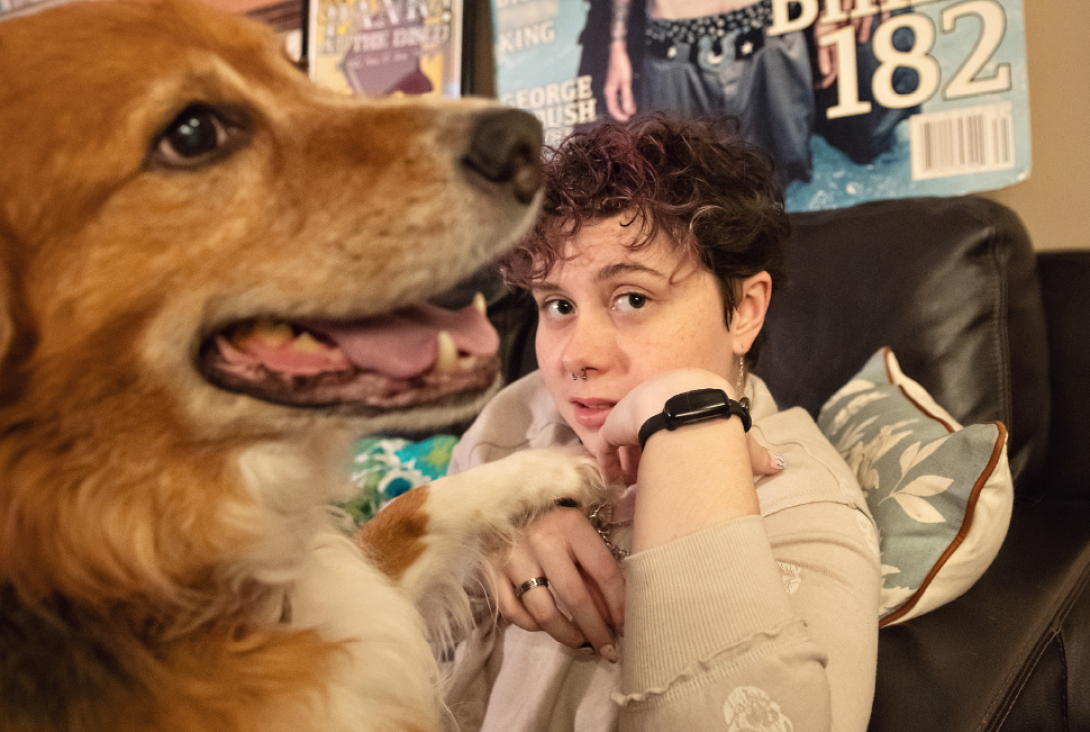
Eric Park has spent time in and out of hospitals, including Mott, to treat mental health issues. It has been a struggle, says his mother Becky Carver (pictured below), but today Eric wants other kids to know that it’s OK to talk about their mental health and to remember, no one is perfect. “Just because something is difficult for you, doesn’t mean that you’re failing,” he says. Photo by Leisa Thompson
Until that point, things had come relatively easy for Eric: he played violin in the youth symphony and cello at school, he swam for the summer swim club, and he did well in school. But middle school brought big changes to the family (including remarriages for his parents, which brought new siblings). Identified as gifted, Eric entered a program in which he was no longer the smartest kid in the room, and getting the grades he had always gotten now required more study. “If I can’t do something immediately, and I’m not perfect at it the second that I start, I think I’m a failure,” Eric says today.
Some might say it was a normal identity crisis that many young teens might face, but Eric is also transgender. “I realized that I was not feeling like a girl at around eight years old. I didn’t know what that meant, and I didn’t know that that was a thing that even happened or existed,” Eric says. “I have a vivid memory of playing [the video game] Club Penguin at 8 years old and talking to someone online and being like, ‘Hey, so you know how I said I’m a girl?’ And they were like, ‘Yeah.’ And I said, ‘I think I might be a boy.’ And that was the first time I ever came out to someone, and I didn’t even know what I was talking about.”
During that first hospital stay, doctors treated Eric’s gender dysphoria, anxiety, and depression. He wasn’t just another patient to these therapists, nurses, and doctors. He was Eric. And being Eric was a big deal to their young patient. “Even though I had just come out and I did not look masculine at all because I wasn’t allowed to cut my hair or anything, everybody called me Eric. Everybody called me he or him. They put Eric on my door. They were all very supportive.”
His family has decided to hold off on any transition therapies until his mental health is more stable. Members of Eric’s family still struggle with Eric’s new identity — some still don’t believe it’s real. But in family-based therapy, they are working through it. “That has been challenging,” Becky says. “I tell those family members that we don’t have to get it, but it’s the way he’s feeling right now. My bottom line is I need to keep my child alive.”
Leaving the gifted program and auditioning for a creative and performing arts program at a local high school helped Eric find some of himself through voice and theater, but by eighth grade, he was in the hospital again with continued suicidal ideation and negative thoughts about himself and his abilities.
It was during these stays that Eric met Joanna Quigley, M.D., associate professor of psychiatry and of pediatrics and medical director of child and adolescent ambulatory psychiatry. As part of Eric’s team, Quigley helped adjust medications to treat the anxiety, depression, and ADHD, and supported therapists who worked with Eric during in-patient and out-patient treatments on DBT (dialectical behavioral therapy), a form of cognitive behavioral therapy aimed at redirecting negative thinking. Part of that therapy was facing these ideas of suicide and learning the difference between intense anxiety and depressive episodes and a true desire to want to die.
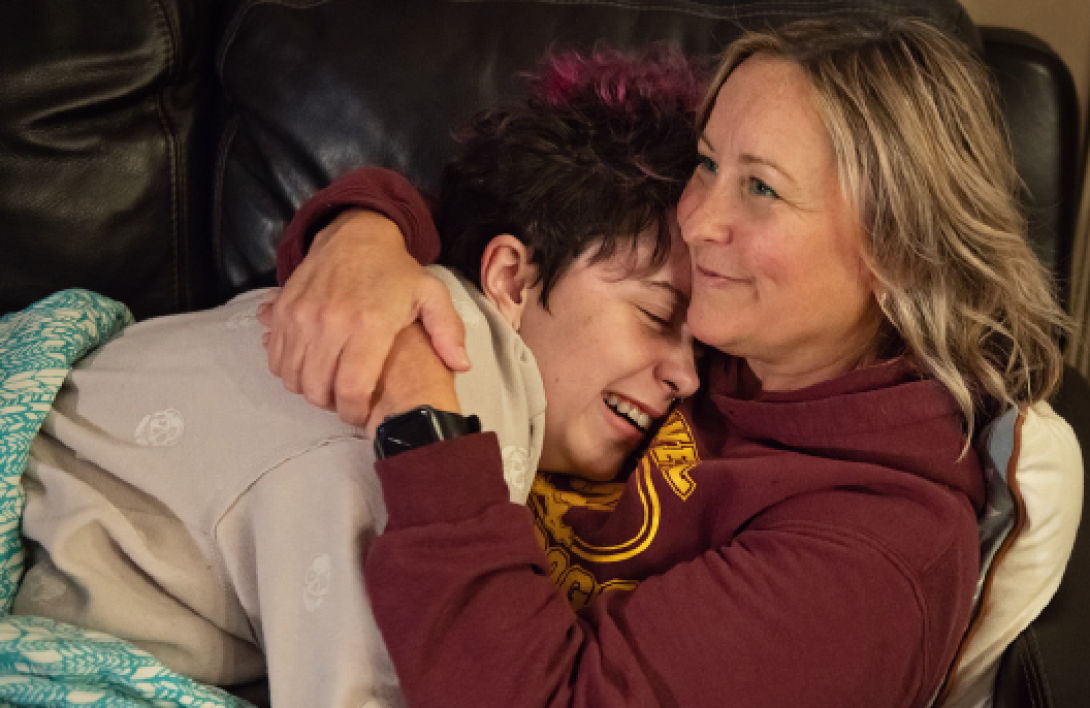
Eric and his mom Becky Carver work with psychiatrists at Mott to help Eric manage his mental health. Photo by Leisa Thompson.
“I’ve had to ask myself, do I really want to die? Or do I want to get out of this situation that I’m in right now?” Eric says. “It took me a long time to separate those two things because there have been a lot of times where I have been so anxious, so stressed, things have just been so much, that it’s like I don’t see a way out of this that I can find.” Part of the DBT treatment that Eric did at Mott is aimed at helping him see other options.
Eric’s voice teacher thinks he should train to become a professional singer at a conservatory, but Becky says, “He’s just not ready to be away from home.” So Eric is working at Busch’s in the deli/bakery and is taking classes at Schoolcraft College.
His last hospital stay is less than a year behind him, but today he is smiling, joking, laughing, talking about his dogs, and offering a little bit of hope to other young patients facing identity issues, anxiety, depression, and suicidal thoughts. “It’s very important for kids to realize that they don’t have to be scared to talk about their mental health,” Eric says. “Just because something is difficult for you, doesn’t mean that you’re failing.”
Communicating without words
Graham Watson loves sensory toys. Most days the 11-year-old can be found walking back and forth to his bedroom, grabbing his favorites, and placing them just so on the family coffee table. When he has completed this activity to his exact specifications, he gets his mother’s attention with vocal sounds and points at the TV when he wants to watch. Today, though, Mom can’t help. The TV is broken. Graham is frustrated but goes back to his pilgrimage to the bedroom for more toys.
Graham is nonverbal autistic, but that doesn’t stop him from communicating. He grunts, laughs, points, and occasionally uses an iPad app to convey his needs. “He is a really, really awesome kid,” says his mom, Cara. “With Graham, there is a unique and complex intersection between his disability, mental health, and medical disorders.”

Graham loves playing with sensory toys and spending time with his sister. Photo by Leisa Thompson.
Cara is careful to separate Graham’s autism from his other mental and physical health challenges, which include epilepsy, agitated catatonia, severe allergies, and “failure to thrive.” “I don’t necessarily find when we’re trying to help him that the autistic behaviors are what we’re really going after,” Cara says. “We want him to be himself, and being autistic is part of who he is.” Her larger concerns center around Graham’s obsessive-compulsive behaviors, anxiety, and agitated catatonia, which can cause Graham to become violent toward himself and others. “He would freeze up and hit himself in the face, and then target me,” Cara says. “We’re definitely covered in scars from it.”
As the episodes continued, Graham’s behavior analyst recommended that Cara reach out to the U-M Nyman Family Unit for Child & Adolescent Mental Health & Wellness at C.S. Mott Children’s Hospital. “It was really the first time that we felt like we were being heard. We had found, when he was having issues in the past, everything just got lumped into autism. His stomach hurts? Well, it’s probably his autism. It was basically what we would hear over and over again,” Cara says. “And so, to have access to people who had more experience and had seen more, and a multidisciplinary team of providers really made a difference. It felt like they were really listening to us. He was actually diagnosed with agitated catatonia the very first day we came in.” After several lengthy stays on the Nyman Family Unit, the Watson family packed up and moved from Traverse City in order to be close to the hospital, where they worked with doctors on medication and ECT treatments, which helped.
But Graham’s care will be an ongoing process. The family is at a point in which previously effective therapies are complicating his other medical conditions. Achieving a balance requires close monitoring from multiple providers.
“It’s been trying to extract what causes what for him. Is it a certain behavior from the autism? Is it a mental health issue? Is it something physical? In the Venn Diagram of his challenges, is it right there in the middle, kind of overlapping?” Cara says. “So, he’s a very complicated case, and they know him very, very well on the eighth floor, for better, for worse.”
Cara isn’t sure what lies ahead. “His challenges ebb and flow, and we’re constantly meeting him where he is and trying to figure out how we can meet his needs and help him grow going forward.” Today, in that ebb and flow, there are smiles shared between Cara and Graham. And though frustrated that his mom is spending too much time on a Zoom call, Graham seems content. He has his toys on the table, and while the TV is broken, an iPad will work just fine.
When food is an enemy
In March 2020, Evan Marshall decided he wanted to lose some weight. He restricted his diet slowly at first, but ultimately to the point that his health was in danger. Evan had become both anorexic and bulimic, had lost a significant amount of weight in a year’s time, and found himself in C.S. Mott Children’s Hospital after blood work with the pediatrician showed dangerous electrolyte levels and extremely low body weight.
This was not Evan’s first hospital stay — he had multiple diagnoses and had been to a couple treatment centers and his doctor’s offices to treat ADHD, generalized mood disorder, anxiety, oppositional defiant disorder, substance use disorder, and other mental health issues. But this might have been the stay during which his mother, Rhonda, felt the most helpless. Her son was dying.
Evan had a bed at Mott for six weeks, with two of those weeks spent in the ICU. It was a very trying time, but Rhonda says she was hopeful. She saw steps of progress. Evan took fluids. Then he drank Ensure and started to eat solid food. His body adapted, and the clinical team felt he was ready to be discharged.
In the intensive outpatient program, Evan worked with the treatment team to plan meals, focus on cognitive behavioral therapy, and even sit down to lunch with his medical team. Therapists also helped Evan build a motivation list of ideas he can turn to if he finds himself rejecting food and struggling. The list includes a desire to stay out of the hospital, a hope to build stronger relationships, travel to Canada to see his family, a plan to keep his job, and a tattoo.
At age 18, Evan is healthier, but treatment is still a daily struggle. He gets frustrated when his brain is telling him to do one thing and his treatment team is telling him another; he struggles to stick to his meal plan; and if you asked Evan about therapy at Mott, he’ll tell you he “doesn’t like it at all.” But even so, he continues — and Rhonda and his team of doctors have vowed to be with him every step of the way.
Even well-meaning adults can be part of the problem
What is it really like to be a young person in America? For the past five years, MyVoice, a Michigan Medicine text message poll of youth ages 14-24 across the nation, has been gathering answers to that question. What researchers have found is an ongoing interest in mental health.
Youth who took a pre-pandemic survey about mental health overwhelmingly thought it was an important part of their overall well-being. They also equated mental health concerns with physical health concerns, like having a broken bone. Because of this, they thought mental health care should be as easy to access as physical health care.
Despite the importance that youth placed on mental health care, there were still barriers to preventive care and treatment. For one thing, the youth were not likely to seek care until they were at a crisis point.
“What sticks out to me is that [caring] adults can still be a problem,” says Melissa Dejonckheere, Ph.D., a professor of family medicine who worked on the pre-pandemic mental health data set. “Even when they might be trying to say something supportive, like ‘This is just a phase. I felt this way too. All teens deal with something like this.’ The youth don’t really perceive that to be helpful. They view it as the adult dismissing their concerns.”
But listening to youth and believing them can be powerful.
“Youth are experts on their own experience,” says Tammy Chang, M.D., MPH, associate professor of family medicine and founding director of MyVoice. That’s one reason youth like to participate in MyVoice surveys.
“Talking about their personal experiences can be an empowering opportunity,” Dejonckheere says.
Resources:
Misperceptions and myths around eating disorders.
What I wish I had known about teens and eating disorders.
A video on the history of electroconvulsive therapy and its use at Michigan Medicine.



